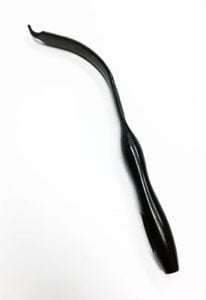For PEEK manufacturers, it’s the physics and materials properties behind the polymer that are most relevant. PEEK’s chemistry is also noteworthy because its chemical structure is what makes the polymer so useful. PEEK is a high-performance thermoplastic, so it possesses an elite range of material properties and is processable using heat.
What is a thermoplastic?
 A thermoplastic is a polymer that retains its plastic properties at standard temperatures, but can be melted at elevated temperatures. When the polymer is returned to its solid, plastic state, it retains its material properties. This is particularly useful for PEEK manufacturers because it means the polymer can be converted into an array of components without compromising its excellent durability and strength.
A thermoplastic is a polymer that retains its plastic properties at standard temperatures, but can be melted at elevated temperatures. When the polymer is returned to its solid, plastic state, it retains its material properties. This is particularly useful for PEEK manufacturers because it means the polymer can be converted into an array of components without compromising its excellent durability and strength.
Thermoplastics are versatile during the conversion process. For example, PEEK is commonly used in the injection and compression molding processes to manufacture large batches of identical components. PEEK can also be machined using CAM technology to create components that adhere to extremely tight tolerances. PEEK can even be extruded to produce medical tubing or used with film calendaring to produce special, atomically-small films.
In medicine, PEEK is converted using injection molding when manufacturing surgical instruments and laboratory components. This is a cost-effective approach that helps medical facilities control infections with single-use instruments. In vivo and implantable PEEK components, though, are primarily converted via machining, which offers better tolerances, smaller production campaigns, and intricate component designs.
What is a semicrystalline thermoplastic?
There are two primary categories of thermoplastics, which are either amorphous thermoplastics or semicrystalline thermoplastics. In practical terms, all polymers sit between perfectly crystalline and amorphous states, but those with a greater degree of crystallinity are called semicrystalline polymers. Both terms refer to the polymer’s molecular structure, and hint at the kind of properties the polymer is likely to exhibit. Here’s a quick look at what amorphous and crystalline mean in a polymer science context:
- Amorphous – Amorphous polymers are organized randomly with molecular chains. With little underlying structure, amorphous polymers tend to melt at lower temperatures, though they perform well at lower temperatures. Amorphous polymers are more flexible than crystalline polymers, but they are more likely to crack under stress and possess poor fatigue strength. Amorphous polymers are also usually transparent. Examples of amorphous polymers include polystyrene, polycarbonate, ABS, polyetherimide and polysulfone.
- Crystalline – Crystalline polymers exhibit structure at the molecular level, most often in small pockets referred to spherulites. In other words, there is significant crystal organization in spots, as well as amorphous areas between the spherulites. This partial crystal structure is what gives PEEK and other semi-crystalline thermoplastics their excellent thermal and fatigue resistance. Because crystalline structures are formed out of more durable bonds, the polymer melts consistently and is tougher once converted into components. Semicrystalline thermoplastics tend to have enhanced bearing and wear properties. Examples of polymers with a high degree of crystallinity include poly-ether-ether-ketone (PEEK), poly-amide (nylon), polyethylene terephthalate (PET), polybutylene terephthalate (PBT) and polytetrafluoroethylene (PTFE).
What are PEEK’s material properties?
PEEK stands out among other polymers with its excellent material properties. It’s these superior properties that have made the polymer a frontline choice in many aerospace, automotive, oil & gas and medical applications. PEEK’s role in medicine has expanded greatly in the last 20 years, and it is now featured in several medical fields, including spinal fusion, orthopedics, cardiovascular medicine, trauma fixation, dentistry and prosthetics, among others.
What has driven this surge in PEEK’s popularity? Several reasons, including:
- An ideal flexural modulus – PEEK can be mixed with several additives, but in its unfilled state, PEEK has a flexural modulus similar to cortical bone. Because it bends and handles weight like bone, it can stand in for bone in several applications. This is most important in spinal fusion, orthopedic and trauma fixation procedures, where the implant must not provoke stress shielding in nearby bone. Stress shielding occurs when the implant bears too much weight and robs native bone of the stimulating stresses it needs to heal and grow properly. Stress shielding is a problem with metal implants and can cause nearby bone to drop in mineral density and suffer from subsidence, or caving in.
- Pure radiolucency – In its unfilled state, PEEK is completely invisible on medical imaging, including CT scans, MRIs and X-rays. This pure radiolucency is essential in spinal fusion applications and any applications where accurate imaging is critical. Because PEEK does not interfere with medical imaging, surgical teams can better monitor the implant’s positioning and potential for osseointegration.
- Total biocompatibility – All implantable biomaterials, PEEK included, must undergo the most demanding safety tests available to ensure the material is safe. PEEK has passed through these tests with no concerns, demonstrating zero cytotoxicity, genotoxicity and immunogenic potential. After 20 years of use in patients, PEEK still hasn’t demonstrated any concerns that would threaten its status as a primary biomaterial.
- Modifiability – PEEK is plenty capable in its natural state, but it can be mixed with other materials to augment its properties. For example, with the addition of chopped carbon (CFR PEEK), the polymer is stiffer and stronger, so it can be used in applications where additional weight bearing capabilities are needed. PEEK’s radiolucency can also be modified with the addition of barium sulfate. This adds a degree of image contrast without affecting the polymer’s properties.
The polymer engineering and science behind PEEK is astounding, but you don’t have to be a scientist to understand what makes the polymer so useful. With its favorable material and mechanical characteristics, PEEK is at the peak of polymer engineering.
